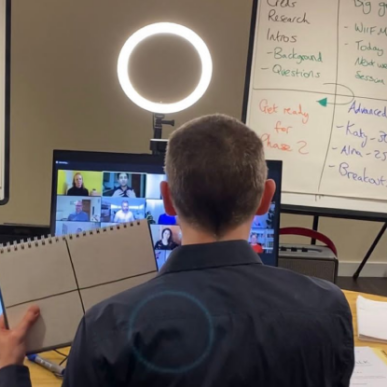“Whether in person or on a screen, the better we communicate, the better we’ll do business.“
7 Tips For Improving Your Virtual Communication Skills
We may feel we’re now experts at Teams, Google Meet and Zoom meetings; they quickly became a part of our business life during the pandemic, whether we liked it or not. After a few months of fumbling around and finding best practices, the virtual platforms helped teams come together, be more productive and find new ways to collaborate. No wonder some companies have decided to offer remote or hybrid working as a permanent option.
There’s no question that virtual platforms will continue to be an essential part of business life moving forward. With more and more of us working remotely, it’s crucial to communicate effectively through digital channels. But virtual communication isn’t just about using the latest technology. Equally important is understanding the nuances of communication and how these can differ in a virtual environment compared to face-to-face.
Why Are Virtual Communication Skills So Important?
Whether in person or on a screen, the better we communicate, the better we’ll do business.
We all know that good communication makes people feel valued and increases efficiency and productivity. It builds trust, improves relationships and helps resolve conflict. It also grows your brand and helps you achieve goals.
If you’re uncomfortable communicating virtually, it can be easy to make mistakes that can damage your professional relationships or make you seem less competent than you are. That’s why learning to communicate effectively in a virtual setting is so important.
So, if you feel there’s a disconnect with your colleagues in virtual meetings (and I’m not talking about the wifi going down!), here are seven tips to improve your virtual communication:
1. Know the features of the platform
There have been lots of updates since we were thrown into virtual meetings in the first part of 2020. For example, Microsoft Teams now has a side-by-side feature when you’re sharing slides, showing the audience a larger video of you alongside the slide deck rather than disappearing into the corner. This increases your impact and stops the slides from taking over the presentation. If a client asks to use a different platform from the one you’re used to, take some time before the meeting to work out how it all works – can you share content easily? What are the default microphone and camera settings? Do you have all the permission you need; to share content or set up break-out rooms, for example? Confidence with the tech allows you to concentrate on your conversation or presentation.
2. Use video
Most of the time, using video will be a massive advantage. Seeing the people you’re talking to during a meeting makes all the difference to the quality of communication. It builds rapport, trust and empathy – which leads to better decision-making. Studies have shown that people are more likely to trust someone they can see, so if you want to build better relationships with clients or colleagues, turn the video on. Of course, there are practical considerations such as internet bandwidth and whether everyone has good enough equipment. But if you have good tech, it makes sense to be as present as possible in the meeting. Video allows you to pick up on nonverbal cues, like body language and facial expressions, which can be helpful in communication. Plus, it’s more engaging than audio only. The only time you might want to switch off your video is if the connection is poor or keeps freezing or if you’re doing a presentation where slides are more important than you being on screen.
3. Make sure your environment is set up for success
Your background says a lot about you, so make sure it’s sending the right message. Check what can be seen behind you and move anything that could be distracting. Virtual backgrounds continue to be popular, but they only work if your lighting is good and you have a green screen; otherwise, bits of you tend to fade in and out of the background, which looks like something out of Star Trek! The ‘blurred’ option on both Zoom and Microsoft teams is better than the full virtual background, but a neutral, tidy normal background often works best. Set your camera at eye level and position yourself, so the light from the window is on your face rather than behind you – we still see so many clients join our virtual training where they are backlit with the window behind them, and you can’t see their face! Check how you sound, often the internal microphone on your laptop or PC can distort your voice without you realising, especially if you’re in a large room. Be careful of headsets and Bluetooth mics, these can make you sound like you’re in a toilet cubicle. External desktop or clip mics are inexpensive and will give the audience a richer, clearer sound.
4. Be aware of your body language
Your body language expresses much more than you might think – it can show interest, boredom, excitement or anxiety. In a virtual setting, these non-verbal cues become much more obvious than face-to-face and small movements, like swivelling in your chair or moving back and forward, draw more attention. Make regular eye contact with the camera so the audience feels more connected to you, and don’t be afraid to use gestures – these bring clarity to your message.
5. Avoid multitasking
The danger of working from home is being distracted is much easier and more common. The doorbell rings, the dog barks, and the family or housemates interrupt. We get it, we’re all facing the same challenges. When you’re communicating virtually, it’s important to give your full attention to the person or people you’re talking to as much as you can. This also means avoiding distractions like checking email, browsing the web, or working on other tasks. If you need to multi-task, let the other person know in advance so they’re not distracted or left feeling ignored.
6. Get the audience engaged
The tech developments over the last few years mean many different tools are at your disposal to create and keep engagement on a virtual call. Interactive slide decks like Slido or Menti are easy to set up and fun for the audience. They can also help if you have a hybrid audience where not everyone can access the chatbox. Use the tech within the platforms like polls and breakout rooms and encourage interaction through annotation tools and emoji responses. Having a clear agenda also helps to keep the meeting on track and consider something called a ‘speedy meeting’. This isn’t where you talk as quickly as possible to get it over with; rather, allocating a certain time period for the meeting, let’s say an hour, but finishing within 45 minutes, so everyone gets some time on their day.
7. Finish on a high
Ending on a strong note is essential to leave a lasting impression. Thank everyone for their time, reiterate the key points and agree on the next steps. If you’re presenting to clients, offer additional resources like links to blog posts or articles that might be of interest. Finally, ensure you follow up after the meeting – this could be an email with the recording or key takeaways or sending through any files or presentations promised. Following up shows you care about the outcome of the meeting and builds trust for future business relations.
Virtual Communication Skills Training
Still need some help? We offer many options to help your team communicate like superstars. From masterclasses for large teams or smaller coaching groups, we have something to fit all time frames and budgets. Get in touch today to discuss how we can help you achieve your communication goals.
You can also watch or listen to your podcast below, where I share tips on virtual communication from my 22-year career as a presenter for the BBC.
The Body Talk Podcast – Virtual Communication Skills from Body Talk on Vimeo.





















